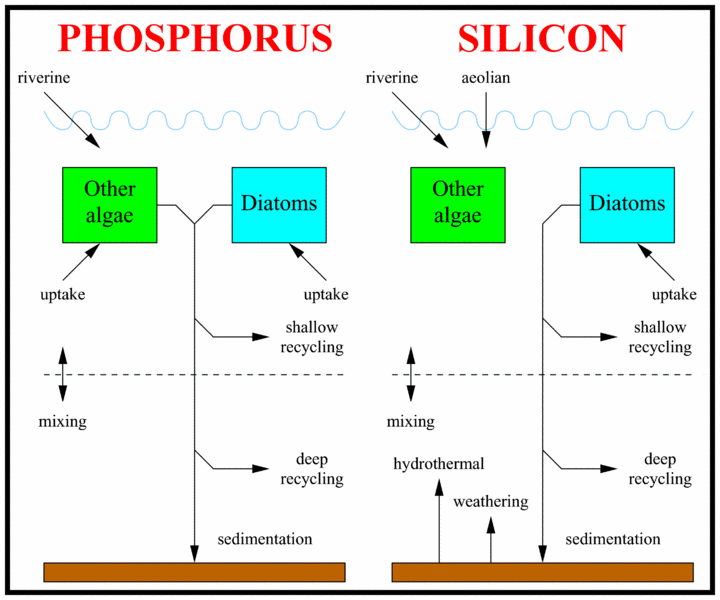
The silicon-phosphorus model is a first-order model of the major source and sink terms in the ocean's silicon and phosphorus cycles, and feedback loops that connect them. The model builds upon the simpler phosphorus model.
Overview
This model is very simple. It is stripped down to the simplest form that can still reproduce the silicon (Si) and phosphorus (P) cycles. That is to say, the simplest form that is still able to capture the main aspects of how atoms of silicon and phosphorus enter the ocean, are transported about within it, and then finally leave the ocean. The aim of this model is to understand how the silicon:phosphate ratio of the ocean is regulated, and also how the amount of phytoplankton in the ocean, and therefore the fertility of the ocean as a whole, are controlled.
The diagram to the right shows how the oceanic cycles of silicon and phosphorus are represented in the model. As well as including the same cycling of phosphorus as in the phosphorus-only model, the model also represents how atoms of silicon enter and leave different substances (for instance, diatom shells or molecules of silicic acid) during their time in the oceans.
The model is a two-box model of the global ocean, where the upper box represents the surface ocean down to the seasonal limit of the deepest wind-induced mixing and the lower box represents the deep ocean below the influence of wind and waves.
Click here for a more detailed description of the silicon-phosphorus model.
Other related pages
Silicon-phosphorus model overview
Silicon-phosphorus model details
Silicon-phosphorus model pros
Silica burp hypothesis
Silicon-phosphorus model worksheet
Refrences
Yool, A. & Tyrrell, T. (2003). Role of diatoms in regulating the ocean's silicon cycle. Global Biogeochemical Cycles 17, 1103, doi:10.1029/2002GB002018.
External links
Description of the chemical element silicon
Diagram of the silicon cycle
Description of the chemical element phosphorus
Description of the phosphorus cycle